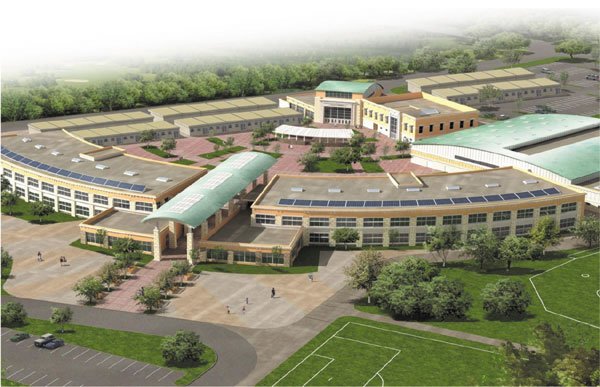More than 100 Christopher High School students, parents and
teachers decked out in school colors crowded into the school
district board room Thursday night and listened attentively as
trustees discussed the possibility of finishing the school using
portables.
More than 100 Christopher High School students, parents and teachers decked out in school colors crowded into the school district board room Thursday night and listened attentively as trustees discussed the possibility of finishing the school using portables.
During the two-hour study session, trustees considered how to approach the completion of the school’s construction given that their facilities funds are going faster than they expected. The options include moving forward with the original $17-million design of the final classroom wing or installing either 36 portables for $5.4 million or several modular, two-story classroom buildings for $19.9 million. The money will come from Measure P, the $150 million facilities bond voters passed in Nov. 2008.
According to Julie Avnet, a financial consultant the school district hired, the district is eligible for about $10 million in state matching construction funds for CHS. The district is getting in line for the money but there are no guarantees, she said.
With the first $50 million of Measure P already spent – mostly on building the first phase of CHS – trustees are hoping to prioritize the growing list of district needs. Rucker and Rod Kelley elementary schools are in dire need of renovations and the Dr. T.J. Owens Gilroy Early College Academy is close behind, trustees said.
The meeting served as an information-gathering session to guide trustees in future decision making, school board president Francisco Dominguez informed the crowd. In order to open the additional classrooms at CHS by August 2011, construction crews need to break ground within the next few months, administrators said.
Jim Moore, a representative from BCA Architects, the firm that designed CHS, walked trustees through the three options, pointing out that the two alternatives to the permanent classroom wing would require replacement after 25 to 30 years. Several CHS parents grimaced when he clicked to the slide showing an artist’s rendition of the campus with 36 portables.
“Completing Christopher High School as designed is a testament to the value that you place on the Gilroy community at large as well as the value you place on our kids in telling them and showing them that you finish what you start. You make a commitment, you adhere to it,” said Guy Hadnot, the incoming president of the CHS Parent Club.
Seven other CHS parents and students spoke during the public comment portion of the study session. Like Hadnot, they urged board members to “keep their promise” to the voters and reminded them that portables weren’t a part of that promise. Two girls held up posters in the back of the meeting that spelled out messages along the same lines.
“Why do a job halfway and repair it every few years when you can do the job the way it should be done and not have to worry about repairs for decades to come?” said Sydney Felix, a CHS student. “Let’s stick to the original plan, finish the job and finish it right.”
Another student, Peter Hilkene, handed over a petition signed by students, staff and community members.
“As an athlete, I have heard visiting teams comment on what a beautiful school we have, and it makes me so proud to be a part of it,” Hilkene said.
The audience cheered when Moore flipped to the last slide of his presentation, which recommended that the board stick with the original plan.
But schools like Rucker are far beyond being concerned with the aesthetics of their campuses. Rucker Principal Jan Boehme is more worried about plugging up the nine leaks in the roof of her computer lab or fitting all her students into the cramped multipurpose room at lunchtime during stormy weather. About three quarters of the Rucker campus is made up of portables, Boehme said.
“The stuff that’s not portables? It’s pretty ancient,” she said. “Our greatest need is all of the above. Technology is huge.”
Although the school district has done a “marvelous job” of equipping the school with computer programs like Successmaker – which is already proving quite successful, according to Boehme – the physical constraints of the school pose a challenge.
Trustees will reconvene June 3 and expect to have more information from the school district about the needs at other school sites and the cost of addressing those needs, Dominguez said. In the meantime, the district is moving forward as if it’s going to build the permanent classroom wing and has already put that project out to bid. It is in the process of interviewing potential contractors, Dominguez said. The design of the classroom wing has already been submitted to the state for approval. Also, whether the district will receive the $10 million in state matching funds is still up in the air. All these elements should become clearer at the June meeting, Dominguez said. At that meeting, trustees hope to decide which option to pursue at CHS and select a contractor, if the decision is to build the permanent wing, Dominguez said.













